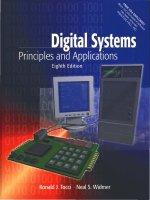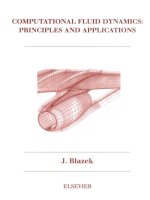Lasers, principles and applications
Bạn đang xem bản rút gọn của tài liệu. Xem và tải ngay bản đầy đủ của tài liệu tại đây (19.39 MB, 328 trang )
PRENTICE HALL
INTERNATIONAL SERIES
INOPTOELECTRONICS
Lasers
Principles
and Applications
J. WILSON
J.F.B. HAWKES
ya
ee tat
ae
tay
;
*
;
le
t
Lasers
Principles
and Applications
hee
Ie
ir: <2
ara
wD
iM a
2
a
ety
4.
+
Â
i
te <4
ae
by
5
has vais ah
ae mor
sae4
<
4
,
.
-
i
ry
ca
*Tim?
a=
Te
;
.
Co
4
id
Ơ
ee
Mee
Â
1
Ơ
:ộ
4
4
Ca
Â
=
=
|
i)
_
&
=f
4
ft
i
*
os
.
Ta
j
>
j
.
ns
cole
+
;
i
ies
.
'
2
e
|
J
Lannea
fe.
,
J
I
ae
ee
By
ey
os
3")
a
;
i
P
ta
+43
wt pe
fA
rot
Pay
(tr
r
Re
ier)
4
Cab
oy
Agee
4>
7
2
ale
ae
itch
hae
v
aon
Ts
al
ie,Lo
ee
& pes
7
"
PROT
oy
ie
es
mee
a
ae
ny
oe
Le
Vs
s
7
i
Â
Fainat
i
tte
al
tal
hora
~
ee
ay
oe
Cee
1
4.
thasâ
ae
ie
is
y
,
aps ~
;
ca
:
at
"
fips
:
Lasers
Principles
and Applications
J. Wilson
J. F. B. Hawkes
School of Physics
Newcastle upon Tyne Polytechnic
Prentice Hall
New York
London
Sydney
Tokyo
First published 1987 by
Prentice Hall International (UK) Ltd
66 Wood Lane End, Hemel Hempstead,
Hertfordshire, HP2 4RG
A division of
Simon & Schuster International Group
© 1987 Prentice Hall International (UK) Ltd
All rights reserved. No part of this publication may be
reproduced, stored in a retrieval system, or transmitted, in
any form or by any means, electronic, mechanical,
photocopying, recording or otherwise, without the prior
permission, in writing, from the publisher. For permission
within the United States of America contact Prentice Hall
Inc., Englewood Cliffs, NJ 07632.
Printed and bound in Great Britain by
A. Wheaton and Co. Ltd, Exeter
Library of Congress Cataloging-in-Publication Data
Wilson, J. (John), 1939-—
Lasers: principles and applications.
(Prentice Hall international series in
optoelectronics)
Includes bibliographies and index.
1. Lasers.
I. Hawkes, J. F. B., 1942—
II. Title. III. Series.
TA1675,.W55
1988
621.366
87-18683
ISBN 0-13-523705-X
British Library Cataloguing in Publication Data
Wilson, J.
Lasers: principles and applications.—
(Prentice Hall International Series in
Optoelectronics).
1. Lasers
I. Title
621.366
II. Hawkes, J. F. B.
TA1675
ISBN 0-13-523705-X
ISBN 0-13-523697-5 Pbk
345
91 90 89 88
Helse sesvO5—%
= 13-Se3b1"=5:
PBR
Contents
Preface
ix
Glossary of Symbols
xi
1
Laser
1.1
1.2
1.3
1.4
Fundamentals
1
The nature of light 1
Emission and absorption of light 9
Interaction of radiation and matter
11
The Einstein relations
13
1.5 The gain coefficient
16
1.6 Attainment of a population inversion
18
1.7 The optical resonator
21
1.8 Threshold gain coefficient
24
1.9 The lineshape function
26
1.10 Laser modes
28
1.10.1
Axial modes
28
1.10.2
Transverse modes
31
Problems
32
References
33
2
Operation of Practical Lasers 35
2.1 Doped insulator lasers 35
2.1.1
Impurity ion energy levels in solids
2.1.2
Pumping methods
39
2.1.3
Fresnel losses 42
2.1.4
The Nd: YAG laser 43
2.1.5
Nd: glass lasers 46
2.1.6
The ruby laser 47
2.1.7.
The alexandrite laser 48
2.1.8 | Color or ‘F’ center lasers 50
2.2 Semiconductor lasers
52
2.3 Gas lasers 63
2.3.1
Atomic lasers 64
2.3.1.1
The HeNe laser 64
2.3.1.2
The copper vapor laser 67
36
Contents
vi
2.3.2
Ion lasers
68
2.3.2.1
The argon ion laser 68
2.3.2.2 The helium—cadmium laser 70
2.3.3
Molecular lasers 71
2.3.3.1
The carbon dioxide laser 71
Sealed-tube lasers
73
Gas flow lasers 74
Gasdynamic lasers 75
Transversely excited atmospheric (TEA) lasers
Optics 76
2.3.3.2 The nitrogen laser 76
2.3.3.3.
The excimer laser 77
2.3.3.4
The chemical laser 78
2.3.3.5
Far infra-red lasers
79
2.4
Pe,
Liquid dye lasers 80
The free electron laser
Problems
References
84
86
88
Properties of Laser Radiation
90
3.1 Laser linewidth 90
my! Laser frequency stabilization 94
333 Beam divergence 96
3.4 Beam coherence
102
Brightness
106
a
3.6 Focusing properties of laser radiation
107
byl Q-switching
108
3.7.1
Methods of Q-switching
110
3.7.1.1
Rotating-mirror method
110
3.7.1.2
Electro-optic Q-switching
111
3.7.1.3
Acousto-optic Q-switching
112
3.7.1.4
Passive Q-switching
113
3.8 Mode locking
114
3.8.1
Methods of mode locking
117
Joo Frequency doubling
119
3.10 Phase conjugation
121
Problems
125
References
126
Metrological and Scientific Applications
128
4.1 Optical alignment
128
4.2 Measurement of distance
131
4.2.1
Interferometry
131
4.2.1.1
Reversible counting
135
4.2.1.2
Refractive index correction
136
75
vii
Contents
4.3
4.4
4.5
4.6
4.7
4.2.2
Surface topography and optical component testing
4.2.3
Beam-modulation telemetry
142
4.2.4
Pulse—Echo techniques
144
Laser Doppler velocimetry
145
Surface velocity measurements using speckle patterns
151
Angular rotation
153
Laser spectroscopy
157
4.6.1
Molecular beam spectroscopy
158
4.6.2
Saturation spectroscopy
159
4.6.3.
Two-photon spectroscopy
159
Laser uranium enrichment
160
Problems
References
5
Industrial, Medical and Military Applications
165
166
oe Theoretical analysis
5.1.1
Temperature changes assuming no melting or
vaporization
168
5.1.2
Melting depths
174
5.1.3.
Vaporization depth
175
176
Diz Beam transport and focusing
179
«ps. Materials-processing applications
5.3.1
Surface hardening
179
5.3.2
Semiconductor processing
182
184
5.4 Laser welding
5.4.1
Microwelding
187
5.4.2
Deep penetrating welding
188
189
=
is) Laser-assisted machining
190
5.6 Laser cutting
193
“py Micromachining
194
5.8 Drilling, scribing and marking
Lasers in medicine
197
5
199
5.10 Very high-power laser uses
5.10.1
Laser-induced nuclear fusion
199
5.10.2
Laser weapons
201
Problems
References
6
162
163
201
203
Holography
204
204
6.1 Introduction
207
6.2 Classification of holograms
6.3 A mathematical description of holography
6.4 Hologram efficiency 218
212
137
viii
Contents
6.5
Applications of holography
219
6.5.1
Holographic interferometry
220
6.5.1.1
Double exposure holographic interferometry
220
6.5.1.2
Sandwich holograms
221
6.5.1.3
Real-time holography
221
6.5.1.4 Time-average holographic interferometry
223
227
6.5.2
Holographic optical components
6.5.2.1
Holographic optical elements (HOE)
228
6.5.3.
Information storage and display 230
6.5.4
Character recognition
233
References
7
233
Optical Information Transmission and Storage
TA
Optical communication
236
7.1.1
Light modulation schemes
237
7.1.2
The optical fiber 241
7.1.2.1
Intermodal dispersion
246
7.1.2.2
Graded-index fiber 248
7.1.2.3. Low-dispersion fibers 249
7.1.2.4 Fiber losses 252
7.1.2.5
Fiber materials and manufacture
7.1.3.
7.1.4
7.1.5
7.1.6
7.1.7.
Optical detectors
258
Emitters
264
System design considerations
Future developments
265
Integrated optics 267
7.1.8
Optical bistability
265
270
7.1.9 | Free-space communication
273
V2 Laser printing 275
es. Optical disk systems 277
7.3.1
Recording
281
7.3.2
Recording media
283
7.3.3.
Data readout from optical disks
7.3.4
Erasable optical disks 289
Problems
290
References
292
Appendix 1
Answers to Problems
Appendix 2
Physical Constants
Appendix 3
Laser Safety
Index
302
236
298
294
297
287
254
Preface
It is now just over twenty-five years since laser action was first successfully
demonstrated using a crystal of ruby as the laser medium. In the time since
then not only has the term /aser been adopted into our everyday speech but
the laser has grown from the status of a scientific curiosity with a few potential applications to that of being one of the most important inventions
of our time. It is now a vital tool for areas as diverse as manufacturing
industries and medicine, an essential component of communication and
holographic systems and the basis of many scientific measurements and
research programs.
The term laser is used here in a general way for there are many different
types of laser with quite different characteristics. All lasers, however, emit
radiation with special properties which enables the laser to be used in a
much wider range of applications than conventional light sources.
In view of the very wide range of applications, there is clearly a need
for those other than physicists to have a good working knowledge of lasers
so that they may better understand the particular application they are
interested in and also appreciate the advantages and limitations of using
lasers. This knowledge will hopefully enable them to make informed
judgments on the purchase of appropriate lasers and associated components. Such people might include mechanical, electronic, civil and
telecommunications
engineers, chemists, life scientists, surgeons,
military
personnel and artists.
In writing this book, we have attempted to present a treatment of lasers
appropriate to the needs of such a wide range of people. It is at an academic
level equivalent to about the second year of a degree program and should
also prove useful to students taking an introductory course in lasers. The
text falls short of a comprehensive quantum-mechanical treatment of the
theory of lasers but does present a much more detailed discussion than the
rather brief reviews contained in many texts on modern optics. We hope
therefore that this text will provide a basis for the study of the more
advanced books cited in the references.
Chapter 1 covers the fundamentals of laser physics while Chapter 2
describes the principles of operation of a quite comprehensive selection of
the various types of laser. Space does not allow an exhaustive coverage and
X
Preface
doubtless we have omitted one or two lasers which will become important
in the near future. We believe, however, that an understanding of these two
chapters will enable the reader to appreciate the operation of new lasers as
they appear.
Chapter 3, which discusses the properties of laser radiation, forms the
basis for an understanding of why lasers are so useful and of many of their
applications. We hope that it will help the reader to devise new applications
in various fields. This chapter also describes some of the ways in which the
laser output can be modified to enhance its usefulness.
Because of the special properties of laser radiation most laser beams
can be focused to a very small spot, in which there is a very high energy density, and Chapter 5 covers some of the applications of lasers which depend
on this. These range from cutting and welding metal sheets to an alternative
to the surgeon’s scalpel. In this chapter, perhaps more than in any other,
we have quoted several useful equations. Space does not permit the derivation of such equations and indeed in many cases this would not help in
understanding the application to which they are related. Full references are
provided to these derivations for the interested reader. In Chapter 6 we have
given a mathematical description of holography and presented some of its
applications. After a rather slow start the range and number of these applications is steadily increasing. Although a full discussion is beyond the scope
of this text, it is hoped that some readers will be encouraged to delve deeper
into this fascinating subject.
Finally in Chapter 7 we discuss the role of lasers in optical communications. Topics covered include laser printers, optical disk systems and, most
importantly, fiber-optic communications, in which there has been a
dramatic growth in the last few years.
We have interspersed a number of worked examples throughout the
text, which we hope will illustrate the use of equations, provide typical
values of various parameters and enhance the reader’s understanding and
enjoyment of the book. There are also end-of-chapter questions with
numerical solutions provided in Appendix 1. Appendix 2 provides a list of
physical constants.
References have also been provided at the end of each chapter. These
include suggestions for further reading as well as specific references to
various points in the text.
Finally we would like to thank our colleagues, particularly Dr I. D.
Latimer, for their interest and many valuable discussions and suggestions,
Mrs Pat Weddell for typing the manuscript and our families for their
encouragement and forbearance.
Glossary of Symbols
Wherever possible we have endeavored to use the commonly accepted
symbols for the various physical parameters needed. Inevitably many
symbols have duplicate meanings, and if in any doubt the reader should
note carefully both the context and the dimensions. The following list of
symbols does not include all the varieties formed by adding suffices, nor
does it include all the (fairly frequent) cases where a symbol is used as a
measure of physical dimensions.
area, spontaneous transition rate (A2;)
fiber radius
Einstein coefficient (Bi2, B21), bit rate
capacitance, specific heat capacity
velocity of light
Diameter, optical density
distance
electric field amplitude
energy, bandgap (£;,)
electron charge
lens F number
modulation frequency, focal length
gain
lineshape function (g(v))
DR
TPMSARAHTQOBS
THON heat flow per unit area
Planck’s constant
=
current, /(—1)
Se
a
~
MN
l
molecular rotational quantum number
total momentum
diffraction factor
thermal conductivity, film development parameter
unit vector, small signal gain coefficient, threshold gain ©
coefficient (kin) Boltzmann’s constant, wave vector.
cavity length, angular momentum, coherence length (L-), heat
diffusion length (Lp), Latent heats of fusion (Lr) and
vaporization (Ly)
mode number
xi
Glossary of Symbols
xii
A
PS
mass
mass, mode number
photon density
number of modes, number density
numerical aperture
electron concentration, intrinsic carrier concentration (nj)
refractive index
power, electrical polarization, pressure
axial mode number, hole concentration
‘quality’ factor
transverse mode number,
spectrum order
electrical resistance, reflectance, ratio of spontaneous
'y
DRODd
a se
eh
bee
ae
Be
ee
a
OS
ae
eee
to
stimulated emission rates
the Rydberg constant
radius of curvature, transverse mode number
spin momentum
fringe separation
transmittance, temperature
time, coherence time (¢,), amplitude transmittance
electric field amplitude (complex)
contact, potential (Vo), voltage, fiber ‘V’ parameter
velocity, group velocity (vg), molecular vibration quantum
number
power
laser beam width parameter
absorption coefficient, angle
phase factor
loss coefficient, mutual coherence function (712), fiber refractive
index profile parameter, ratio of electron energy to rest energy,
photographic film density parameter.
relative fiber refractive index parameter
phase angle
electric permittivity of free space
angle, Brewster angle (6g)
thermal diffusivity
light wavelength
magnetic permeability of free space
lightwave frequency
material density, radiation energy density
lifetime, time
phase angle, work function, lens aperture
Sigke,
ee
ek
SS
corp
~x
electric susceptibility
phase factor
angular velocity
angular frequency
Laser Fundamentals
1.1
THE
NATURE
OF LIGHT
The term Laser is an acronym formed from /ight amplification by stimulated
emission of radiation. Thus to understand the operation of lasers, the
special properties of their radiation and their application, we must
familiarize ourselves with the present ideas concerning the nature of light.
The Greeks were almost certainly the first to try and explain the nature
of light and how vision takes place. Then the advent of experimental science
brought about two rival theories. These were the corpuscular theory of
Newton, who suggested that light consisted of streams of particles which
obeyed his dynamical laws of motion and the wave theories of Hooke and
Huygens, who assumed that light had a wave-like nature.
For any theory of light to be accepted it must be able to explain
observed phenomena such as reflection, refraction, diffraction and interference. Diffraction is the name given to the ability of light to ‘bend round
corners’ to a certain extent, so that shadows of an object cast on a distant
screen are not perfectly sharp even when a point source of light is used. We
would expect sharp shadows to be formed if light travelled in straight lines,
that is, if it showed rectilinear propagation. Interference is a related
phenomenon resulting when light from two or more coherent (refer to
Section 3.4) sources combines to form regions of alternating darkness and
brightness; these regions are called fringes. (For a more complete description
of these optical phenomena see Ref. 1.1.)
Both theories were able to account for some of the phenomena mentioned above, but interference, first demonstrated by Young in 1801, could
be explained only in terms of light waves. Young’s experiment is shown
schematically in Fig. 1.1. Light from a point source falls onto a screen
containing two pinholes which in turn act as point sources. Consequently
the light from the pinholes has the form of two overlapping spherical
wavefronts (see below). It the light is allowed to fall onto a second screen
a system of interference fringes forms. The bright fringes form when two
Or more waves combine together in phase so as to reinforce one another;
dark fringes form when the waves are out of phase and cancel each other
1
2
1
Laser Fundamentals
Dy,
[\SAS\S
VINIrradiance
, C distribution
[
\
Screen
1
Screen 2
Fig. 1.1
Schematic arrangement for Young’s experiment to demonstrate
interference. P, P; and P2 are pinholes which act as point sources of
light.
(Fig. 1.2). Young called these situations constructive and destructive interference respectively.
Clearly as we move across the screen the relative distance (D; ~ D2) of
points on the screen to the two pinholes P; and P) varies so that the relative
phases of the waves arriving at these points changes. There is, therefore, a
gradual variation from an exactly in-phase to an exactly out-of-phase situation, with a consequent gradual change from bright fringe to dark to bright
and so on. It is convenient to measure the path difference from each point
on the screen to the pinholes in terms of \, the wavelength of the light. Thus
for example if the path difference is a whole number of wavelengths then
a bright fringe is formed.
Diffraction phenomena can easily be explained in terms of Huygens’
principle of secondary wavelets. Huygens assumed, in order to explain the
propagation of light through apertures and past obstacles, that each point
on a wavefront acts as a secondary source of light and that wavelets spread
out from these points. Then, after a short time, the new wavefront is the
surface which is a tangent to all the wavelets. This is much easier to show in
a diagram than it is to explain in words and Fig. 1.3 is almost self evident.
By a wavefront we mean all points where the light waves have exactly the
same phase, thus for example, the wavefront from a point source is the
surface of a sphere (providing the medium surrounding the source is
optically uniform). The spreading of light through an aperture is easily
accounted for in terms of Fig. 1.4, which also indicates, with alittle
1.1.
The Nature of Light
3
Component waves
Resultant
(b)
Fig. 1.2
In (a) waves from the two sources arrive at screen 2 in Fig. 1.1
exactly in phase and combine together (or interfere constructively) to
give a bright fringe. In (b) two waves arrive at the screen exactly out
of phase and cancel each other (or interfere destructively) to give a
dark fringe.
thought, that the smaller the aperture the greater will be the diffraction, that
is, the amount of spreading of the emergent wavefront.
We see then that a wave theory can easily account for interference and
diffraction phenomena while a corpuscular theory cannot. Young was able
to explain other phenomena such as the formation of colors in soap films
or thin films of oil on wet surfaces in terms of a wave theory by associating
different colors of light with different wavelengths. He also suggested that
polarization of light can come about only because light has a transverse
wave nature. By this we mean that the vibrations of the light waves are
perpendicular to the direction of travel, unlike the situation with sound
traveling through fluids, where the waves are Jongitudinal with the vibrations along the direction of travel.
In a plane polarized beam of light all of the waves have their vibrations
coplanar as opposed to the random orientation of the planes of vibration
of unpolarized light — the situation is illustrated in Fig. 1.5.
Additional evidence in favor of a wave theory was provided by
Fresnel’s quantitative explanation of diffraction in terms of light waves,
while a major advance in understanding the nature of light was made by
Maxwell in 1864. Maxwell combined the experimental work of Faraday,
Oersted and Henry on electricity and magnetism into a set of equations
from which he deduced the existence of a transverse wave whose speed c in
4
1
Laser Fundamentals
em
oe
HK
eH
0HO
Oe
WO
ee
Re
me
en
ee
me
Original plane
wavefront
Fig. 1.3.
An illustration of the application of Huygens’ principle to the propagation of a plane wavefront (dashed lines). The small circles represent ‘point sources’ on the original wavefront which emit secondary
wavelets. The new wavefront at a later time is the resultant of these
secondary wavelets. The diagram shows (in an exaggerated way)
that an initially plane wavefront will diverge as it propagates.









